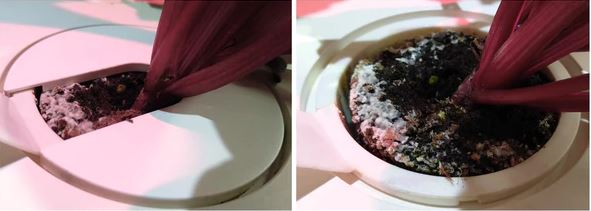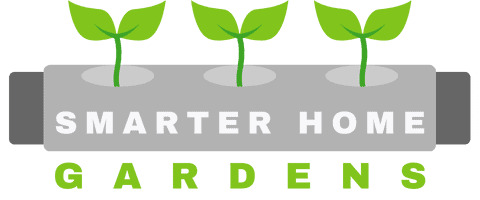This post contains affiliate links. As an Amazon Associate, SmarterHomeGardens.com earns a small commission from qualifying purchases at no extra cost to you.

When I was about 3 weeks into growing my first batch of plants in my Click & Grow Smart Garden 3 I noticed that the top of my seed pods was covered in white mold. Naturally, I was worried that this mold might damage my plants or even be harmful. So, I did some research, and here’s what I found.
The white mold that can sometimes grow on top of your Click & Grow seed pods is a type of common saprophytic fungus. This mold is completely harmless to humans and will not cause disease in your plants. However, if desired, it can easily be cleared away using only a paper towel.
In this post, I’ll go into a little more detail about what this mold is, what causes it, and how you can prevent and remove it to keep your Click & Grow in good working order.
What is the white mold on your Click & Grow?
The white mold that sometimes grows on top of the Click & Grow seed pods is a type of saprophytic fungus. Saprophytic fungi are common in nature and are one of the most active decomposers present in the soil. Sarophytic fungi, in fact, are an essential part of every ecosystem. Without them, organic material would not break down and we’d be living under a thick blanket of dead leaves and wood!
What does saprophytic mean?
The vast majority of fungi are saprophytic. This means that they feed exclusively on dead organic material, such as leaves and decaying plant material. Pathogenic fungi, in contrast, feed on living material.
Leading causes of white mold in your Click & Grow seed pods
Damp soil, poor drainage or contaminated soil are all leading causes of the saprophytic fungi that create the white mold you see growing on your Click & Grow. Because of the nature of wick hydroponics (the type of hydroponics system used by Click & Grow), the soil is continually damp and therefore can make a good environment for the fungi’s spores to germinate.

These spores exist everywhere and are very difficult to completely expunge from your environment, even from the Click & Grow Smart Soil itself. So you shouldn’t worry if you see white mold on your Click & Grow. It’s completely normal.
The fungi usually exist as invisible tubular structures called ‘hyphae’ that branch into dead organic matter and break it down. These hyphae can aggressively multiply in your Click & Grow to create visible white ‘mycelium’, especially within older pods where some of the organic matter has died.
Is the white mold on my Click & Grow harmful?
Can it make you sick?
No. Because the mold is saprophytic, it doesn’t feed off living material. Although it might not look very nice, it cannot make you sick and is not harmful to humans.
Can it cause problems for your plants?
In general, no. Because the type of fungi that constitutes the ‘mold’ are saprophytic (meaning it only feeds on dead organic material) it cannot cause problems like disease or damage to the plants growing in your Click & Grow Smart Garden.
In rare cases, if left unchecked, the fungi’s mycelium can start to fruit (creating mushrooms/toadstools). These fruiting bodies are harmless but can cause an unpleasant smell or smother young seedlings in the worst cases.
Removing white mold from your Click & Grow seed pods
Removing the white mold from your Click & Grow seed pods is only really necessary for aesthetic purposes as the fungi will not cause harm to your or your plants. However, should you still wish to remove it, then it’s super easy to do.
Wipe the mold away with a dry paper towel
Removing the fungi’s mycelium ( which creates the visible white mold) is straightforward. Grab a paper towel or dry cloth from the kitchen. Then, wrap it tightly around your index finger. Using this finger, gently scrape away the mold from around the base of each plant, being careful not to cause any damage to new seedlings or stems. It really is as simple as that!
Check out this quick video showing your exactly how to do it:
How to prevent white mold from growing on your Click & Grow
It’s very difficult to prevent white mold from forming on your Click & Grow seed pods. Saprophytic fungi are everywhere (which is a good thing) and their presence within the Smart Soil is completely normal. However, there are a couple of steps you can do to minimize the chances of mycelium (the visible white parts of the fungi) forming.
1. Remove dead and dying material from the base of your plants
Saprophytic fungi feed on dead organic material, breaking it down into nutrients that can then be reabsorbed. While this process is an essential function in nature, it can be halted by removing its food source. Keep removing as much dead material from around the base of your plants as you can. This can help to stop the fungi from growing too rapidly and forming the visible white mycelium.
2. Sprinkle cinnamon around the base of each plant
It may seem a little odd, but sprinkling a little cinnamon around the base of your plants can stop the fungi’s mycelium from forming and therefore preventing the white mold from appearing. Cinnamon is well known for its ability to prevent fungi from forming.
In conclusion
The white mold you see forming on your Click & Grow seed pods is caused by a harmless saprophytic fungus that is not dangerous to either you or your plants in the vast majority of cases. The main reason for removing it is purely aesthetic, but it can be done so easily using nothing more than a paper towel. Sprinkling a little cinnamon around the base of your plants and removing dead material can help to prevent the fungi from forming viable white mycelium.
